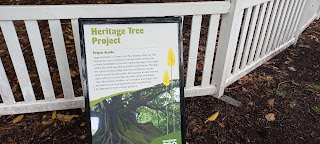A Day at the Zoo
 |
| 2020 |
Usually visiting the Melbourne Zoo Royal Park mid-week is one of the best times, uncrowded and except for the odd school tour, relatively quiet. But we picked a day that was cold wet and windy, you know? Melbourne winter.
The animals were on a wet day timetable and weren’t in the mood to be
seen that day. We were the ones walking around in the rain. Proof was in the
offering that we kid ourselves that we are Mother Nature’s smartest species.
 |
| 1922 |
The list of animals I partially saw or just didn’t see included the Lions,
Orangutangs, Lemurs, Tasmanian Devils, Great Tortoise, pigmy hippos, wild dogs,
and surprisingly, the penguins and seals who really don’t seem affected by bad
weather because they’re always wet.
 |
| 1950s |
The Elephants were staying put, they were having pedicures in their big
steel barn. I knew it wasn’t our day when we grabbed a hot tea at the aptly
named Giraffe Lookout café which sat high and directly opposite the
Giraffe enclosure to have them immediately herded into another paddock while
the curators cleaned their living quarters. I wasn’t going to let this little
trip go to waste. Especially when I realized that the zoo had been operating
here for over 160 years. There had to be a lot of history in this place.
 |
| 1956 |
I needed to know how much was still here or even hidden away.
The Elliot Ave. entrance is like an old friend and with the brick outer
walls extending each side, it has barely changed since I was a preschooler. My
earliest memories were of the seal pool, which my dad told me used to be a
monkey enclosure until the monkeys realised, they could jump over the moat and
escape. I looked it up later, it was true and the enclosure was an art deco
masterpiece, though not necessarily the most comfortable enclosure. It has now
been replaced by the spectacular Wild Sea exhibit where the seals swim
around you.
Just a short walk from Wild Sea, a massive Moreton Bay Fig that has survived many zoo reinventions and has been in the same spot for 110 years and is used as a scientific barometer for environmental studies such as CO2 emission data. Also, nearby which made childhood memories come flooding back, the fun fair which seemed huge when I was younger has been removed, the only thing remaining now is the original carrousel which is now over 140 years old and still operates.
I thought I was doing a good job of finding the obvious, when I walked up a path that terminated abruptly by a low gate with a Staff Only sign on it. Standing at the gate I could see in between the trees the old Elephant sheds that once sat on a flat sandy area that had a deep concrete pit surrounding it.
 |
| pre 1980 |
This prompted me to check out some material I have at home. The Zoo’s 150 Anniversary booklet and an old zoo map from the 1980s. Here I found proof of how much the landscape had changed in this relatively small area. I was complaining about the Giraffes earlier but it’s still one of two exhibits that seem unchanged from my childhood memories (which is true, it has been in the same spot for over one hundred years), that and the reptile house, which I will never look at the same way since I saw the first Harry Potter movie. The zoo to its credit doesn’t shy away from what it used to cage the animals in. Two well-preserved brick and steel bar enclosures still stand.
One small loungeroom sized cage that once housed the big cats, the other a slightly larger and higher cage of similar build that housed the smaller primates and now holds the colourful Macaws which it is more suited to. The former actually held a Thylacine or Tasmanian Tiger back in the 1920s, then it was referred to as a Tasmanian marsupial wolf.
 |
| 2000s |
The Zoo these days is known for its research, breeding, animal studies and
education, and more importance is put on the comfort and welfare of the
animals. Which shows how far we have come as a society. 100 years ago, the zoo
had a museum featuring stuffed animals that had died there and held elephant
rides as a supplementary income for the organization. I remember as a child
seeing animals crammed into small concrete pits and steel cages whereas in 2024 the elephants
are leaving Royal Park and being transferred to Werribee free range zoo, where
they will have an area to wander larger than the whole Melbourne Zoo area, as
opposed to the current area equivalent to a small football oval. I may not have
seen many animals on this horrible wintery day but at least I got to take a
deep dive into exploring some history.
I also recommend a visit to the State Library website and check out the
zoo’s maps over the years. Fascinating stuff. Just type Melbourne Zoo map into
the search box and explore.








